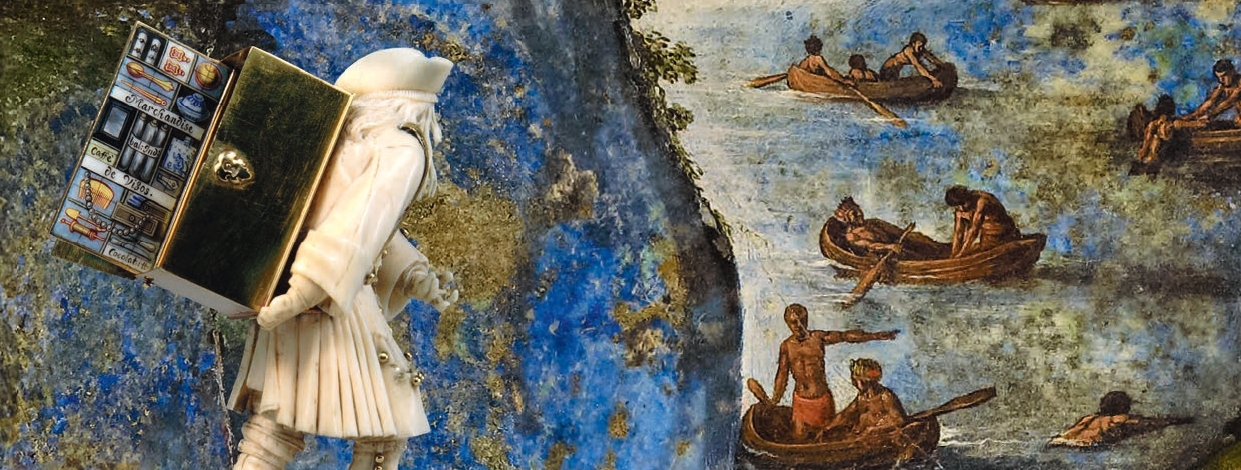The Petite Galerie’s 6th season complements the cycle of exhibitions that the museum is dedicating, in 2021/2022, to discoveries and explorations of lands near and far: ‘Paris–Athens: The Birth of Modern Greece, 1675–1919’ (30 September 2021–7 February 2022) and ‘Pharaoh of Two Lands: The African Epic of the Napatan Kings’ (27 April–25 July 2022).
Through travelling materials and objects, the Petite Galerie’s new exhibition aims to tell the tale of the world and its peoples by describing exchanges between distant worlds – exchanges often far more ancient than the explorations of the 16th century.
Materials brought from the ends of the earth
From deepest antiquity, carnelian, lapis lazuli, ebony, and ivory circulated along trade routes: these materials were even more precious because they came from afar. Their fascination was enriched by the myths surrounding their origin. Their use became a manifestation of prestige, and the meaning of the works of art that employed them was thus enriched, modified, amplified. From the Head of Gudea, Prince of Lagash to a small lapis lazuli bead in the shape of a frog, the exhibition presents these materials in great variety.
Ivory sculpture: carving the elephant’s tooth
Among the many materials supplied by nature to art are the teeth of large animals – hippopotamus, boar, narwhal, mammoth, and elephant. As part of the Petite Galerie’s accessibility outreach, this year visitors will have the opportunity to touch an elephant’s tusk.
Portraits of animals come from afar
Not only stones, shells, and plants travelled between continents; so did live animals, often for political ends. The populace as well as artists discovered ostriches, giraffes, and elephants, which became objects of fascination. Manmade objects followed the same routes; beyond Europeans’ well-known yen for exoticism, this exhibition shows that these multiple round trips wove a more complex history.
An object, a story
Works of art came to life through the materials chosen by artists, but their story then underwent the hazards of travel, taste, and transformation. Forms, techniques, and themes intertwined to create new objects, reflecting all the complexity of our world as it could be perceived in Europe from the late Middle Ages on. Each work recounts a different story, from the long voyages, often still mysterious, of the Middle Ages, to far-flung trade, to the moment in the 16th century when the world globalized. In the 19th and 20th centuries, military and scientific expeditions provided still other sources of exchange and transfer.
Customized digital tools
A dedicated website (petitegalerie.louvre.fr), offering visitor trails for teachers and for professionals working in the social sector and accompanying disabled individuals, a virtual tour, a signed tour in LSF (Langue des Signes Françaises), a tour for visually-impaired visitors, and additional information about featured artworks, allowing visitors to plan and make the most of their time at the exhibition. As every year, visitor trails through the museum collections expand upon the theme of the Petite Galerie exhibition.
Special guest art: music
Every year, the Petite Galerie hosts an art that is not shown in the museum. This year, music makes the exhibition sing, with a programme at the Louvre auditorium.
Exhibition curators: Philippe Malgouyres, curator at the Department of Decorative Arts, Musée du Louvre, and Jean-Luc Martinez, honorary president of the Musée du Louvre
Project manager: Florence Dinet, Musée du Louvre
| Exhibition catalogue Edited by Philippe Malgouyres and Jean-Luc Martinez, with Florence Dinet Co-published by: Musée du Louvre Editions and Editions du Seuil Bound, 192 pages, €32 |
The Louvre’s Petite Galerie has received the generous support of the Fondation PSA, the sponsorship of the Fonds Handicap & Société by Intégrance, a donation in memory of Anne Cox Chambers by Alex Taylor, the generosity of Madame Krystyna Campbell-Pretty and the Campbell-Pretty family, as well as that of the Fonds Susan D. Diskin, Ph.D., as part of the Louvre endowment fund.

